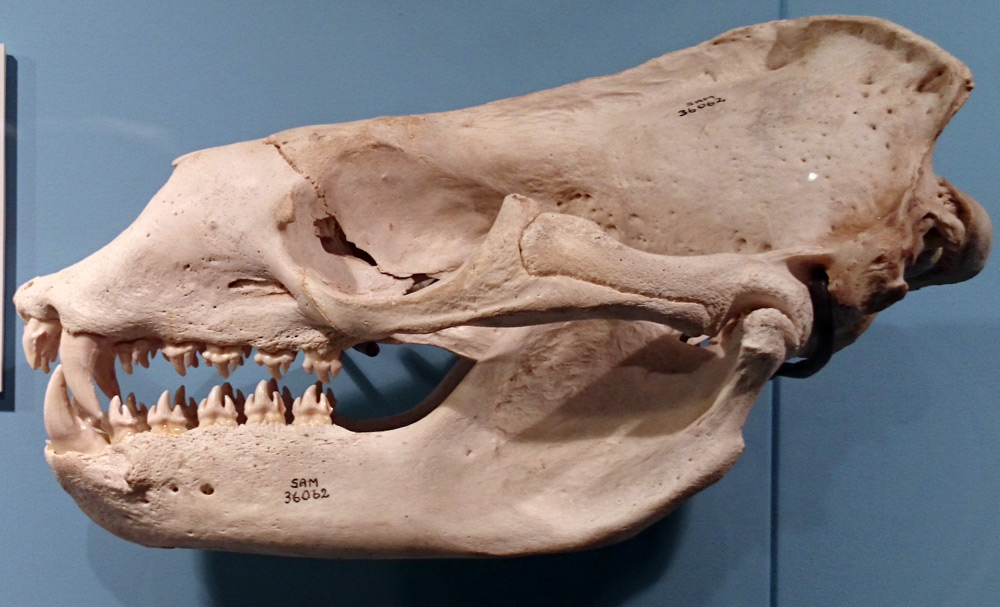|
|
Post by creature386 on Jul 26, 2020 2:28:48 GMT 5
About terrestrial crocodiles, TierZoo has recently mentioned them in his new video on crocs: He has basically argued that they suck because terrestrial crocodiles and similar animals (e.g. rauisuchia) arose multiple times in Earth's history, but unlike their aquatic cousins, they never really caught on. Of course, similar arguments could be used to invalidate almost any hypothetical super-predator and it's very well possible that the changes Supercommunist proposed might be just what's needed for them to complete the jump. Still, I thought it'd be interesting to share. |
|
|
|
Post by Infinity Blade on Jul 26, 2020 3:32:53 GMT 5
Notosuchians lasted for a little over 100 million years (assuming sebecosuchians aren't among them), and exploited a variety of niches, including hypercarnivorous forms. Sebecosuchians lasted from the Middle Jurassic to the Middle Miocene, giving them a temporal range of 156 million years.
Even disregarding this, the fact that they convergently arose so many different times throughout Earth's history ("rauisuchians", Redondavenator, chimaerasuchids, all notosuchians, planocraniids, and mekosuchines) shows that they work damn well.
If that's his argument for why terrestrial crocs suck, then I wonder what TierZoo thinks of sabertooths. Because you could say the exact same thing about them.
|
|
|
|
Post by Supercommunist on Jul 26, 2020 23:28:28 GMT 5
I don't consider tier zoo a reliable source of information, it seems every time I click on his videos he gets some fact wrong or he has a weird tier placement.
Like his claim that dinosaurs took out rausuchians is just misinformation, not to mention animals like Razanandrongobe existed when dinosaurs got in their groove.
The terrestrial "crocodilian" body plan has be repeated too many times throughout history to be dismissed as unsuccessful.
His claim is also weird because in another video he places entelodonts are S tier, even though they didn't last nearly as long.
|
|
|
|
Post by Supercommunist on Oct 22, 2020 6:03:37 GMT 5
So leopard seals have always been my favorite pinnipds and I like them more now that I know they are capable of eating krill efficently despite the fact they lack the usual filter feeding adaptations. If I were to create some utimate giant underwater predator I'd create a pilosaur with the back teeth of leopard seal. I imagine that the teeth would compromise the lethality of its bite by a bit, but the ability to feed on high concentrations of krill would enable it to easily fufill its calorie requirments and fuel its growth to become a ridiculously huge macropredator.  |
|
|
|
Post by Infinity Blade on Oct 23, 2020 7:24:08 GMT 5
^I wonder if there's an even better way to go about having teeth for macropredation while being able to filter feed.
Some ancient mysticetes like Aetiocetus had both teeth and baleen in their jaws. Obviously the reason for this was to evolve increasingly towards filter feeding with baleen and no teeth, but there was a point where baleen whales had both. This way a predator might be able to dedicate all of their teeth towards killing large prey, while still having baleen to filter feed.
Then again, I'm not sure if we know for sure that Aetiocetus was filter feeding really small organisms (i.e. krill) instead of just fish or squid.
|
|
|
|
Post by Supercommunist on Mar 13, 2021 5:31:00 GMT 5
Just curious, has there ever been an aquatic animal that developed the super strong and light, honeycomb-like bone structures dinosaurs and birds developed?
I know blue whales are basically as big as a species of animal can fuctionally get, but I wonder how big an aquatic animal could be if it evolved a top tier bone structure as well.
|
|
|
|
Post by Infinity Blade on Mar 13, 2021 6:50:45 GMT 5
I think some animals have some pneumatic bones localized to one body part (e.g. manatees have inner skull structures similar to those of elephants, which have pneumatic crania), but I'm not aware of any in which these bones make up an extensive proportion of the skeleton. It doesn't seem like it would be advantageous underwater either. After all, the animal wants to be submerged underwater, and pneumatic bones (assuming they are lighter) would make that harder. If the bone material itself is denser, and the skeleton overall weighing the same (as in birds compared to mammals), then that defeats the purpose of lightening the bones.
|
|
|
|
Post by Supercommunist on Jun 23, 2021 23:56:57 GMT 5
|
|
|
|
Post by Infinity Blade on Jun 24, 2021 0:51:49 GMT 5
Woah!
I was imagining more stoutly built jaws, but yeah, more or less, I guess. I also wasn’t sure what to do with the sail, but that gave me an idea.
|
|
|
|
Post by Supercommunist on Oct 12, 2021 23:17:45 GMT 5
I've noticed animals with straight stabbing bills have incredible damage potential: Loon kills larger bald eagle with a stab to the heart: www.livescience.com/loon-stabs-bald-eagle.htmlNeedle fish have been known to kill much larger humans, won't post image because it's pretty graphic but you can easily find it yourself. And of course there are swordfish:   However, they are problems with large stabbing bills: 1: Recoil. When you hear accounts of swordfish killing large animals, there is a good chance that said fish broke its bill during the attack and I don't believe they can regrow them. Even if the stabbing bill itself is not broken, good chance that its weapon is trapped inside its victims body. I cannot imagine that swordfish was very mobile with a seaturtle skewered on its bill. 2. It is difficult to dismember prey with a stabbing bill. Not a coincidence that macropredatory birds have hooked beaks and I find it very interesting that in the case of eagles, hawks, and the like, their mouths are secondary weapons. I suspect that their small hooked beaks were never that good at dispatching prey which necessitated the development of powerful grasping talons. Of course terror birds existed which shows that hooked beaks can be effective primary weapons, but I am kind of curious what a giant terrestrial bird with a stork-like bill could accomplish. So what kind of adaptations do you think an animal would need to develop a stabbing bill while also being a macropredatory creature. Hatzegopteryx is one example, but to be honest, I am not entirely sure if I would consider it that impressive since it lived an insular enviroment and did not face much competition. Of course, you could say the same about komodos, and those guys clearly have some gnarly jaws, but serrated teeth have been proven to work, whereas stabbing bills usually belong to fish eaters or small prey specialists. On another subject: I've been getting into spec evo projects recently and have seen quad wing designs: Would that actually be benefical? Or is that a simplistic view that more = better?  www.deviantart.com/sheather888/art/The-Seamingo-753790886 www.deviantart.com/sheather888/art/The-Seamingo-753790886 www.deviantart.com/sheather888/art/Sandpiping-Seraph-875194387 www.deviantart.com/sheather888/art/Sandpiping-Seraph-875194387 www.deviantart.com/sheather888/art/Endling-880467357 www.deviantart.com/sheather888/art/Endling-880467357 |
|
|
|
Post by Infinity Blade on Oct 13, 2021 1:40:20 GMT 5
|
|
|
|
Post by Supercommunist on Oct 13, 2021 6:13:11 GMT 5
I totally forgot that animal existed. I wonder if it actually used its bill to kill similar sized prey. Wouldn't it have struggled to get the body off its nose?
|
|
|
|
Post by Supercommunist on Oct 24, 2021 7:57:03 GMT 5
Thoughts on the best weapon for delivering venom? I always thought the gila monster style dentition would be pretty useful. It can inject a lot of venom but its teeth also look like they can inflict a lot of damage without it.  Also would be curious to know cases of arthropods killing other animals with just the force of their stinger alone. |
|
|
|
Post by Infinity Blade on Oct 24, 2021 8:05:19 GMT 5
Are gila monster teeth serrated like Komodo dragon teeth? I might have said Komodo dragons as an answer (when it comes to tooth damage combined with venom), but I'm convinced that they're not actually venomous as is so often claimed.
|
|
|
|
Post by Supercommunist on Oct 28, 2021 0:02:22 GMT 5
I don't think they are. Also I am also not sure if komodo's are venemous. It's kind of weird how science keeps changing its mind on the subject.
But for what it's worth, this video exists:
|
|